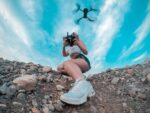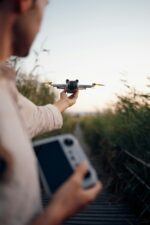We independently evaluate all of our recommendations. If you click on links we provide, we may receive compensation.
Drone Laws and Restrictions You Should Know
Updated on July 31, 2024
What are the different drone laws and restrictions you should know? Are there local restrictions that you need to follow?
Do authorities ban drones in certain places? Do I really need to register my drone?
The moment I bought my first ever drone made me really tempted and excited to fly it in that very moment.
However, I also learned that there are things a drone pilot should consider first before venturing into the exciting world of drones.
As a matter of fact, you can see drones drones flying everywhere: roads, parks, mountains and many more.
Although this is really good to see, they might also cause some serious problems like accidents and privacy issues if the drone pilots aren’t aware with drone laws and restrictions.
Today, drones already became one of the most advanced and well-equipped devices so before owning one, you must certainly know the rules that you need to follow all the time.
Always remeber, “with great power, comes great responsibility”, it might just be a movie reference but trust me, it should also be your go to motto when you want to acquire a drone.
7 Drone Laws and Restrictions Before Takeoff
1. Registration and Requirements
Are you concerned that authorities might confiscate your drone? In many nations, especially in the US, drone owners must first register their drones with aviation authorities before using them.
They explicitly make sure that drone operators will be accountable (in-case of accidents) and will aid authorities in the fast-growing number of drones in the air.
On the other hand, you might have heard about Federal Aviation Authority’s rule under small unmanned aircrafts that don’t exceed the weight limit.
The specific regulation states that drones weighing under 250 grams (0.55 lbs) are NOT REQUIRED to be registered or carry their ID.
Hence, authorities consider them “harmless”; however, they still need to follow other drone laws and restrictions to avoid penalties and prevent injury to other people or properties.
For this reason, registering your drone will always make things safer and worry-free towards operating it.
2. Airspace Restrictions
Picture yourself getting your first drone and the excitement of flying it for the first time. You found a beautiful spot and turned on your drone as you watch how it fly gracefully over the skies.
Well, this might sound great but you should also be aware of the drone laws and restrictions in specific airspace to avoid putting your aircraft at risk.
Drone operators must know the no-fly zones that usually include areas around, in and on the government buildings, military sites and airports.
Safety and security of the operator and airspace are the purpose of these limitations.
Hence, flying in these restricted zones will put you and your drone at risk and authorities might treat it as a possible security threat.
Now, if you really want to operate a drone, it’s mandatory to educate yourself about these following airpace regulations:
1. Temporary Flight Restrictions (TFRs)
Authorities implement these restrictions in areas where there are large gatherings, disasters, or other major events.
2. National Parks and Wildlife Reserves
A lot of national parks and wildlife reserves encourage drone-free zone to protect wildlife and visitors.
3. Airports
There is a 5 mile restriction towards drones that fail to notify air traffic control.
4. Sports Stadiums and Arenas
Authorities ban flying drones due to safety concerns, especially in crowded areas like these.
5. National Security Areas
Well, as you know, authorities ban drones because of national security reasons.
6. Class A, B, C, D, and E Airspace (What are these?)
- Class A Airspace: The highest level of controlled airspace. It starts at 18,000 ft. above sea level and extends to 60,000 ft. It is only accessible to aircrafts under Instrument Flight Regulations (IFR) and they should maintain contact with Air Traffic Control (ATC) and have clearance from them.
- Class B Airspace: Authorities enforce this rule around busy airports or areas with larger air traffic. It requires clearance from ATC and the drone must have a Mode C transponder.
- Class C Airspace: This rule also applies in busy airports but with lesser restrictions than Class B airspace. Drones must have two-way radio communication with ATC.
- Class D Airspace: Authorities enforce this rule in smaller airports with control towers. Drones must have two-way radio communication with the control tower.
- Class E Airspace: The one that has the least level of controlled airspace. It starts at 700 ft above ground level to 17,999 ft.
The good news is, DJI drones already have the technology to automatically stop or restrict you from flying inside the restricted Airspace.
This buit-in technology are found in most of their drones like DJI Mavic 3 Pro, DJI Air 3, and DJI Avata
Signs or Clues You Should Know for Airspace Restriction
- FAA Airspace Map: Federal Aviation Authorities gives maps and resources that indicates prohibited airspace.
- No-Drone Zone Signs: Many areas (especially in drone-free zones) have these signages.
- Notice to Airmen (NOTAM): Authorities issue these temporary restrictions, which can be viewed online and through aviation apps.
Correspondingly, it’s always better to schedule your flights appropriately to avoid these kind of problems.
3. Height and Distance Limits
Operating and flying a drone towards the limitless sky is always an exciting and thrilling experience but keep in mind that there are also drone laws and restrictions on how far and the altitude you can go.
Authorities always encourage drone pilots to learn these rules and to abide by them to prevent flying above the given limit.
Most nations (especially US) have dedicated time to impose height and distance restrictions to protect people on the ground as well as other aircrafts.
Federal Aviation Administration’s (FAA’s) limitations for RECREATIONAL DRONES:
- Recreational drones are only allowed to fly below 400 ft. (121.92 m) from ground level.
- They must always keep visual line of sight from the pilot or known observer.
- They prohibit these drones to fly near people or other aircraft.
For COMMERCIAL DRONES (imposed additional restrictions):
- Commercial drones always require remote pilot certificate.
- They must maintain 100 mph (87 knots) groundspeed.
- They only allow these drones to fly during daylight or civil twilight hours
Exceeding these restrictions will endanger other aircraft and violate the safety regulations implemented to keep everyone safe.
Always follow these regulations and research more if there are additional or special restricitions in your area. It’s always better to be safe than sorry later on.
4. Visual Line of Sight (VLOS)
Ready to explore the skies? You already know the different primary restrictions in your area? Well, as you takeoff, you begin to think of how far can your drone travel?
Drone owners should always know that they must maintain the visual line of sight of their drones all the time, despite the urge of testing its boundaries and limitations.
The trick of always keeping the visual line of sight is just by simply operating the drone where you could see it clearly with your naked eye and not just depend on the drone’s camera
This is really important in avoiding obstacles and keeping control which will ensure a safe and fun flying experience.
Meanwhile, flying beyond the VLOS will increase the possiblity of losing control of your drone and the danger towards other aircraft and people around the area.
KEEPING EVERYONE SAFE IS A MUST, you might think its just a simple task to do but it’s different story when you’re with other people.
5. Privacy Concerns
Soaring high and enjoying the landscape and you take amazing aerial photos to commemorate it. You then pass over a community and eventually question yourself, am I violating someone’s privacy?
It is definitely inappropriate to use drones with cameras to invade someone’s privacy.
Drone operators must be aware of privacy concerns and just avoid flying over private vicinities without the owners’ consent.
This includes watching over private properties and NOT TAKING PICTURES OR FILMS when people doesn’t allow it.
Respecting others’ confidentiality and having admirable common sense are the only things you need to avoid being sued or punished.
REMEMBER: Always fly with caution and think about how your actions might affect other people and yourself.
6. Commercial Use Restrictions
As you further venture into the world of drones, you discovered that they can also be commercially used like aerial photography services, delivery tool, mapping and surveying.
Eventually, you want to start flying your drone for business and taking on clients but you found that there are more regulations and rules that you must follow.
- Secure a Remote Pilot Cetificate from FAA (Federal Aviation Authority) for commercially used drones.
- The drone MUST BE REGISTERED with FAA.
- Flight times should start 30 minutes before official sunrise to 30 minutes after official sunset with your local time.
- Flying drones under the influence of alcohol or drugs is STRICTLY PROHIBITED.
- Always maintain visual line of sight with the drone during operation.
- Do not fly the drone over people and when you’re in a moving vehicle.
- Beware of airspace restrictions around the area of operation.
Even though these extra rules could appear overwhelming at first, they are necessary to guarantee that drone operators follow the strictest guidelines for professionalism and safety.
7. Safety Precautions
Safety should always come first when using a drone. Drone operators need to follow best practices, which begin with doing extensive pre-flight inspections, to guarantee safe flights.
These inspections include looking for any damage on the drone, making sure the batteries are completely charged, and making sure the propellers are attached firmly.
It’s also very important to keep a safe distance from people and property. It certainly lessens the chance of accidents, but it also demonstrates consideration for other people’s safety and privacy.
Additionally, it is advisable to stay away from flying in bad weather, like rain or strong winds, as these can endanger the drone’s safety as well as that of other aircraft.
Today, there are drones that are well-known because of their very safe structure and design like DJI Ryze Tech Tello, DJI Mavic 3 Pro, Glorale F08, and many more.
Author’s Advice
Being responsible at all times is necessary. We don’t want to be in a bad position just because we are having fun or doing our job.
Always be respectful and responsible towards following rules and regulations given by the authorities.
We are now enjoying the benefits of drone technology and we can enhance it further when we can minimize the risk of hurting ourselves and the others.













